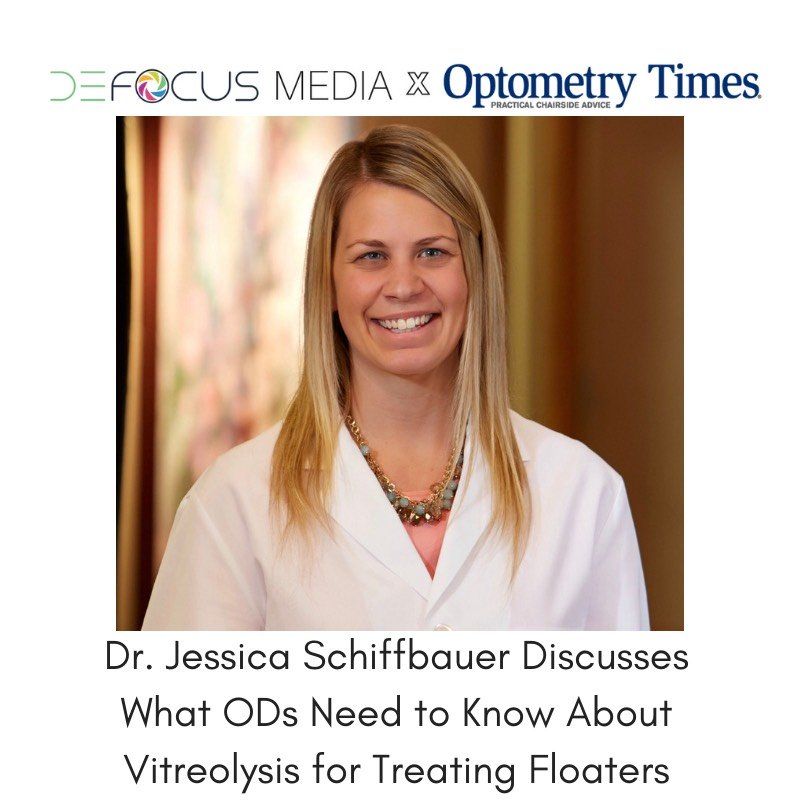What ODs need to know about YAG laser vitreolysis for floaters

After practicing for even just a short time, optometrists can typically spot a patient with posterior vitreous detachment (PVD) from the triage phone call when they booked their appointment.
Whether it’s the classic “bug in my eye” description or “spiderwebs across my vision,” the symptoms are typically a lot worse than the long-term ocular health impact. Studies show between 8-15% of patients with acute PVD have an associated retinal break that needs repair, but that the symptoms of flashing lights and floaters associated with acute PVD where there is no retinal break only last on average up to 3 months. Previously by Dr. Lyerly: First impressions of Acuvue Oasys with Transitions contact lenses
For some patients, however, the floater itself is a cause of significant disturbance. What can we do for patients whose lives are disrupted by the presence of a large, persistent floater?
Dr. Jessica Schiffbauer is an optometrist at Virginia Eye Consultants, an OD/MD referral clinic. A day in her practice involves post-operative care, dry eye referrals, and plenty of flashes and floaters complaints. Many patients come in with visual complaints of floaters as well, and the severity of their complaints can sometimes be surprising. She’s noted many cases where patients complain their floaters cause difficulty driving, reading, or enjoying their work or daily life. In these cases, patients are interested in pursuing treatment options for their floaters and often come in having done research online about their potential options.
Historically, the only treatment option for a patient with disruptive, persistent floaters was vitrectomy. Most doctors would equate treating a floater with vitrectomy to using a grenade to treat an ant hill, but opinions are shifting as technology improves. Vitrectomy has significant potential for side effects, including cataract development, suprachoroidal hemorrhage, and risk for retinal detachment.
As ophthalmologists have moved to performing vitrectomy with a smaller 27 gauge needle, more retinal surgeons are considering vitrectomy for patients with symptomatic floaters, however.
Related: Experiencing retinal detachment as an OD
For Dr. Schiffbauer’s patients that complain of floaters, she recommends that they wait at least 3-4 months to see if their floater complaints improve before pursuing any treatment. If at this follow-up visit the patient is still extremely symptomatic, a discussion of vitrectomy is warranted. Many patients come in to this follow-up visit having researched an alternative to surgery: YAG laser vitreolysis. While her practice does not offer this treatment option, there is a slowly growing number of ophthalmologists around the country that are offering it as an alternative treatment for symptomatic floaters.
Vitreolysis is appealing to patients because it is much less invasive than surgical vitrectomy, but there are still significant risks associated. The procedure involves aiming a YAG laser at the dense floater body to break it up into smaller fragments away from the visual axis. This typically takes 150-200 pulses to accomplish.
Potential side effects include IOP increase, cataract formation or pitting of the pseudophakic lens, and retinal tear or detachment. Because vitreolysis does not completely remove all floaters, the best candidates are patients with well-defined, isolated Weiss rings. Studies have shown mixed success. Also by Dr. Lyerly: What happened in Oklahoma: Expanding scope of practice and protecting what has been earned
A study by Dr. Singh of 296 eyes resulted in 93% patient satisfaction with their floater symptoms after YAG laser vitreolysis treatment, but a study by Dr. Shah of 52 eyes showed only 54% of patients undergoing vitreolysis reported improvement in their floater symptoms. Careful patient selection and patient education about expected outcomes is key.
While there are still only a handful of surgeons offering vitreolysis treatment around the country, the numbers are growing as more promising research becomes available and well-researched patients become more interested in pursuing this option. Dr. Schiffbauer shares how to discuss this procedure and its potential side effects with curious patients in this month’s podcast.
Read and listen to more Defocus Media podcasts here and here
Newsletter
Want more insights like this? Subscribe to Optometry Times and get clinical pearls and practice tips delivered straight to your inbox.